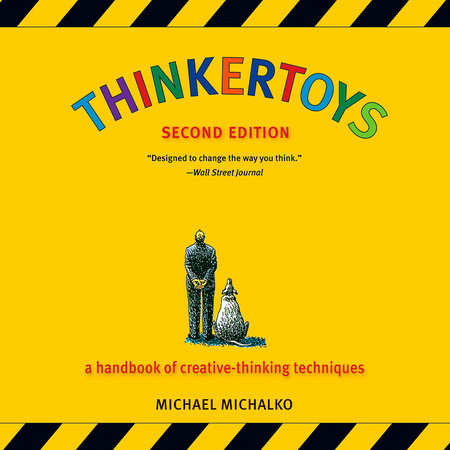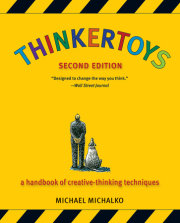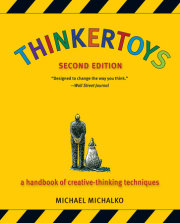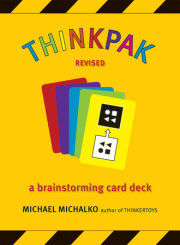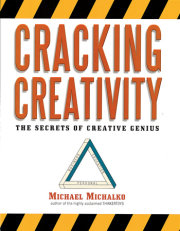IntroductionTHE BARKING CAT What would you think of someone who said, “I would like to have a cat, provided it barked”? The common desire to be creative, provided it’s something that can be easily willed or wished, is precisely equivalent. The thinking techniques that lead to creativity are no less rigid than the biological principles that determine the characteristics of cats. Creativity is not an accident, not something that is genetically determined. It is not a result of some easily learned magic trick or secret, but a consequence of your intention
to be creative and your determination to learn and use creative-thinking strategies.
The illustration below shows the word “FLOP,” which we all know and understand. Look at it again. Can you see anything else?
Once we see the word “FLOP,” we tend to exclude all other possibilities, despite the strange shapes of the letters. Yet if you look at the “O” in flop, you can see a white “I.” Now if you read the white outlines as letters with the “I,” you will see the word “FLIP.” Flip-flop is the complete message. Once found, it seems so obvious that you wonder why you were, at first, blind to it.
By changing your perspective, you expand your possibilities until you see something that you were unable to see before. This is what you will experience when you use Thinkertoys. You will find yourself looking at the same information everyone else is looking at yet seeing something different. This new and different way of seeing things will lead you to new ideas and unique insights.
Thinkertoys train you how to get ideas. They are specific hands-on techniques that enable you to come up with big or small ideas; ideas that make money, solve problems, beat the competition, and further your career; ideas for new products and new ways of doing things.
The techniques were selected for their practicality and range from the classic to the most modern. They are divided into linear techniques, which allow you to manipulate information in ways that will generate new ideas, and intuitive techniques, which show you how to find ideas by using your intuition and imagination.
A popular children’s puzzle shows six fishermen whose lines are tangled together to form a sort of maze. One of the lines has caught a fish; the problem is to find which fisherman it belongs to. You are supposed to do this by following each line through the maze, which may take up to six tries, depending on your luck. It is obviously easier to start at the other end and trace the line from the fish to the fisherman, as you have only one possible starting place, not six.
This is how I researched and developed Thinkertoys. Instead of presenting a catalog of all known creative techniques and abandoning you to
puzzle out which ones actually work, I started with the
ideas (fish) and worked backwards to each creator (fisherman). Then I identified the technique that caught the idea.
Some readers will feel that they profit more from the linear techniques and will discount the intuitive ones. Others will prefer the intuitive and discount the linear. You can produce ideas using both the linear and intuitive techniques, and should not limit yourself to one or the other--the more ideas you generate the better.
This book will change how you perceive your own creativity, while stripping creativity itself of its mystique. You will, perhaps for the first time, see endless possibilities stretching before you. You will learn how to:
• Generate ideas at will.
• Find new ways to make money.
• Create new business opportunities.
• Manipulate and modify ideas until you come up with the most innovative and powerful ideas possible.
• Create new products, services, and processes.
• Improve old products, services, and processes.
• Develop solutions to complex business problems.
• Revitalize markets.
• See problems as opportunities.
• Become more productive.
• Be the “idea person” in your organization.
• Know where to look for the “breakthrough idea.”
• Become indispensable to your organization.
Thinkertoys do not
render the creative experience, they suggest it. To illustrate, let us imagine me drawing a rabbit on a blackboard. You say “Yes, that’s a rabbit,” although in reality there is nothing on the blackboard but a simple chalk line. The rabbit appears because you have accepted my motion that the space within the line suggests a rabbit. The line limits the content by suggesting
a significant form. I must stress that it is not enough to read the book--to create your own ideas, you have to use the techniques. Try to explain the joy of skiing to a bushman who has never left the desert. You can show him some skis and a picture of a snowy mountain, and perhaps get some of the idea across. However, to fully realize the concept of skiing our bushman must put on the skis and head down a mountain. If you merely read these techniques, you will have no more than a suggestion of how to get ideas. You’ll be like the bushman standing in the desert, staring at a pair of skis and a photo of the Matterhorn, with a small notion of what skiing might be.
Each Thinkertoy is a specific technique for getting ideas to solve your challenges. Each chapter contains a blueprint that gives precise instructions for using the technique and an explanation of why it works--including anecdotes, stories, and examples of how real heroes used each technique to produce ideas and breakthroughs. I call them heroes because they left behind a mark, a sign, an idea, an enterprise, a product, or a service that reminds us of their innovation.
I also use illustrations, puzzles, charts, and hypothetical examples to demonstrate how various techniques work. Some of these hypothetical examples present usable ideas for new businesses, products, and services. These ideas are the gold beneath the river of words continually rushing past.
Each chapter begins with an inspirational quote from
The Art of War by the legendary master, Sun Tzu. Sun Tzu wrote his extraordinary book in China more than 2,400 years ago, but his principles are as applicable to
creativity in business as in warfare. Long a classic for Japanese businesspeople, his book is now required reading at many leading international business schools. From Tokyo to Wall Street, business leaders quote and apply the principles of Sun Tzu.
This new edition contains new Thinkertoys “Lotus Blossom,” and “True and False,” updated examples, and an entirely new group-brainstorming section with several new techniques.
A friend of mine, Hank Zeller (an executive, entrepreneur, inventor, and poet), once described creativity this way: “When you realize that you just came up with an idea that betters anything that has been done, well, your hair stands up on end, you feel an incredible sense of awe; it’s almost as if you heard a whisper from God.”
Copyright © 2006 by Michael Michalko. All rights reserved. No part of this excerpt may be reproduced or reprinted without permission in writing from the publisher.

